Embark on a historical journey through the “Blank Map of WWII Europe,” a captivating exploration of the pivotal events and transformative changes that shaped the continent during one of its darkest chapters. This map serves as a blank canvas upon which we paint a vivid tapestry of battles, territorial shifts, and the enduring legacy of a global conflict.
As we delve into the intricacies of this map, we’ll uncover the strategic importance of key geographical features, trace the major battlefronts and campaigns that raged across Europe, and examine the profound impact on cities and historical sites.
Historical Context
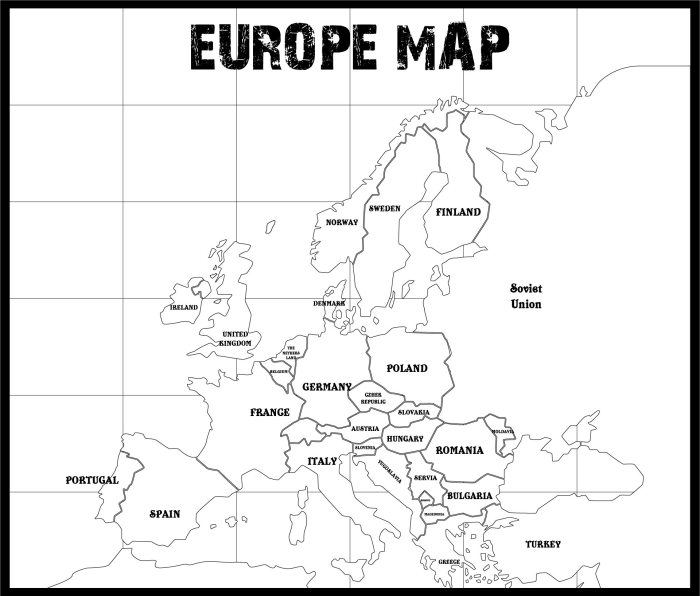
World War II in Europe was a conflict that engulfed the continent from 1939 to 1945, involving the vast majority of its countries, including the great powers: France, the United Kingdom, the Soviet Union, and Nazi Germany.
The war began with the invasion of Poland by Nazi Germany on September 1, 1939, and ended with the unconditional surrender of Nazi Germany on May 8, 1945.
Major Belligerents
The major belligerents in World War II in Europe were:
- Axis powers:Nazi Germany, Fascist Italy, and Imperial Japan.
- Allied powers:United Kingdom, France, Soviet Union, United States, and China.
Map Analysis
A blank map of Europe during World War II provides a visual representation of the geographical context of the conflict. By highlighting key geographical features, borders, and major cities, we can better understand the strategic importance of these elements in the war.
The map should include features such as:
- Major rivers, such as the Rhine, Danube, and Volga
- Mountain ranges, such as the Alps, Pyrenees, and Carpathians
- Major cities, such as Berlin, London, Moscow, and Paris
- National borders, both before and during the war
Strategic Importance
These geographical features played a significant role in the war. Rivers provided natural barriers and transportation routes, while mountain ranges formed defensive lines. Major cities were centers of industry and population, making them strategic targets. Borders defined the areas of conflict and influenced the course of the war.
Territorial Changes
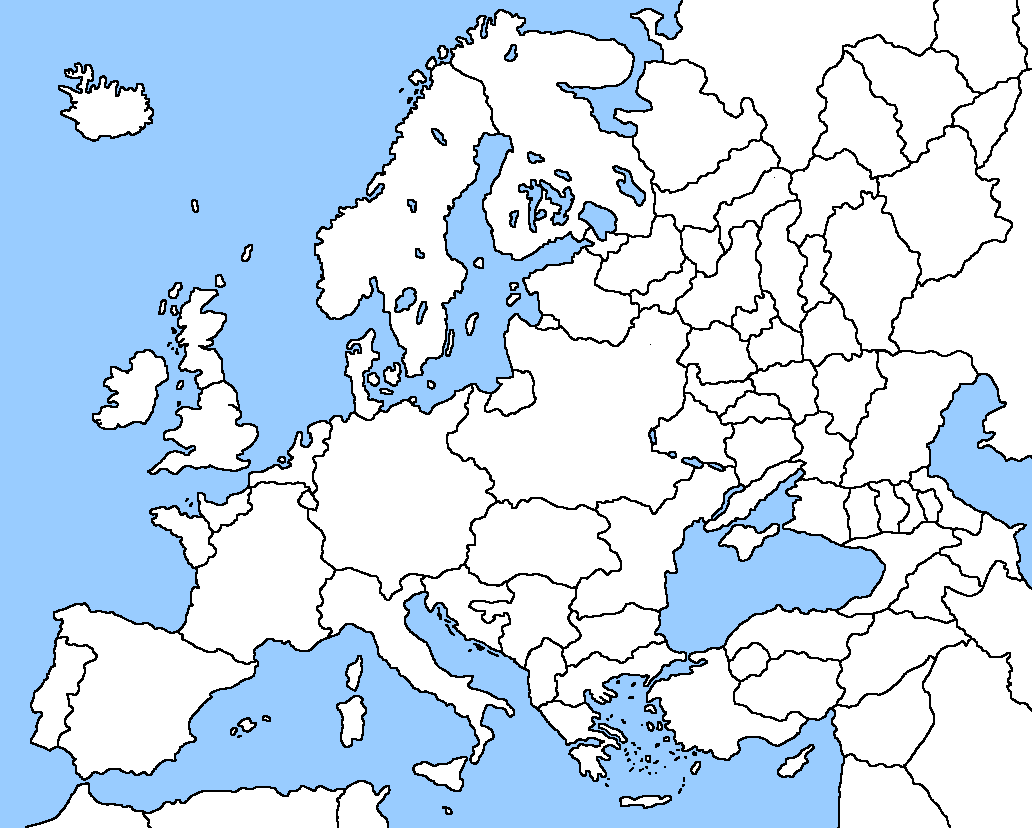
The territorial changes that occurred in Europe during World War II were profound, reshaping the political landscape of the continent. The war led to the redrawing of borders, the creation of new states, and the displacement of millions of people.
One of the most significant territorial changes was the annexation of Austria by Nazi Germany in 1938. This event, known as the Anschluss, marked the beginning of Hitler’s aggressive expansionist policies.
Another major territorial change was the invasion of Poland by Germany in 1939, which triggered the outbreak of World War II. The German invasion of Poland was followed by the occupation of Czechoslovakia and the invasion of the Soviet Union in 1941.
At the end of the war, the Allies divided Germany into four occupation zones. The Soviet Union annexed the eastern part of Germany, while the western part was divided into three zones occupied by the United States, Great Britain, and France.
The territorial changes that occurred in Europe during World War II had a lasting impact on the continent. The war led to the creation of new states, such as the Federal Republic of Germany and the German Democratic Republic, and the redrawing of borders, which shaped the political landscape of Europe for decades to come.
Pre-War and Post-War Borders of Key Countries
The following table compares the pre-war and post-war borders of key countries in Europe:
| Country | Pre-War Borders | Post-War Borders |
|---|---|---|
| Germany | Included Austria and Czechoslovakia | Divided into four occupation zones |
| Poland | Included parts of Germany and Czechoslovakia | Shifted westward, annexing parts of Germany |
| Soviet Union | Included parts of Poland and Romania | Expanded to include eastern Germany and other territories |
| France | Included Alsace-Lorraine | Regained Alsace-Lorraine |
| Great Britain | No major territorial changes | No major territorial changes |
Battlefronts and Campaigns
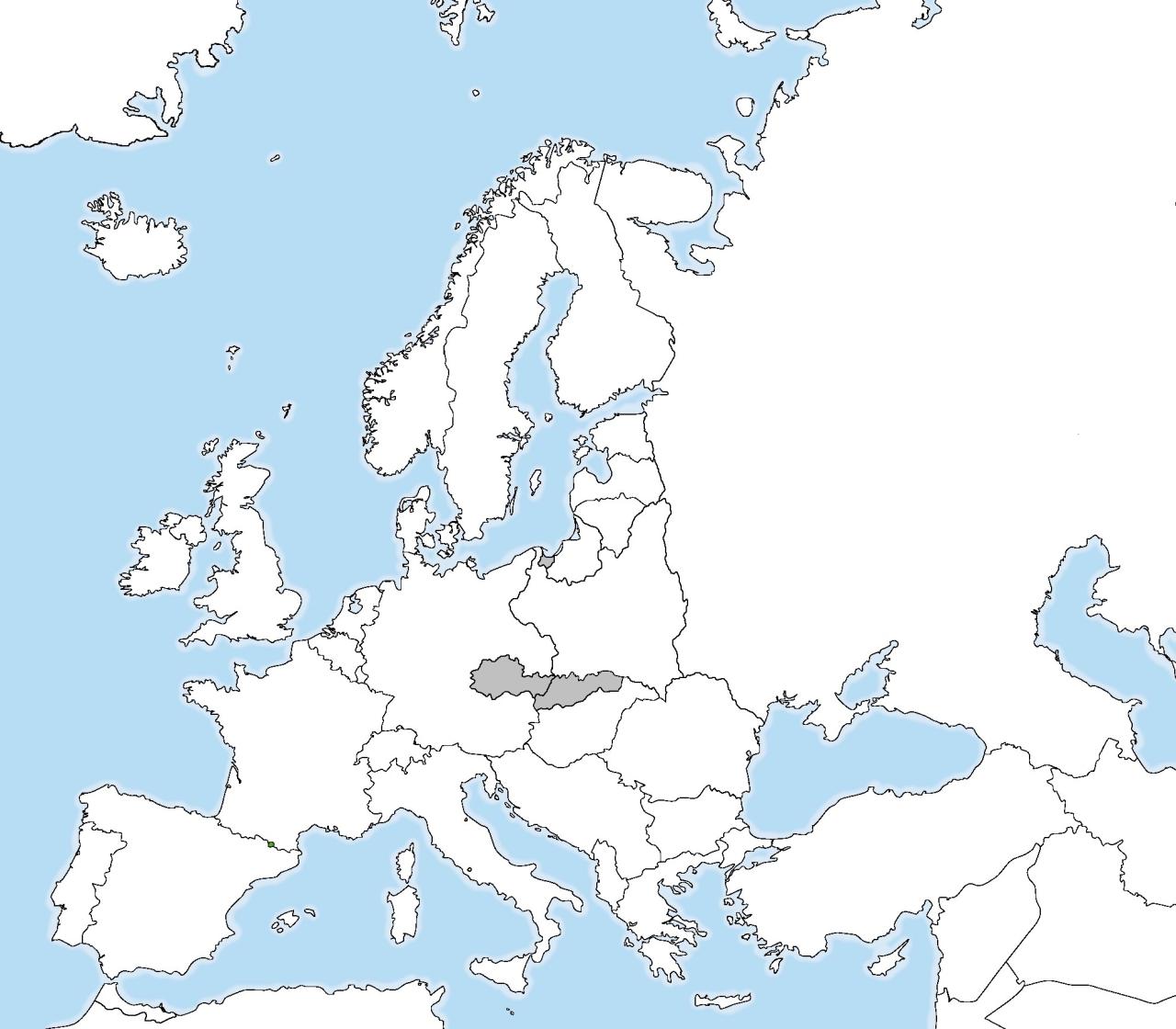
World War II was fought on multiple fronts across the globe, from the beaches of Normandy to the jungles of the Pacific. Each campaign had its own unique set of challenges and objectives, and the outcomes of these battles would shape the course of the war.
The major battlefronts and campaigns of World War II include:
Western Front
- Battle of France(May-June 1940): Germany invaded and conquered France in a matter of weeks, forcing the British to evacuate from Dunkirk.
- Battle of Britain(July-October 1940): The German Luftwaffe attempted to gain air superiority over Britain, but was defeated by the Royal Air Force.
- D-Day(June 1944): The Allies invaded Normandy, France, and began the liberation of Western Europe.
Eastern Front
- Operation Barbarossa(June 1941): Germany invaded the Soviet Union, launching the largest land invasion in history.
- Battle of Stalingrad(August 1942-February 1943): A brutal urban battle that turned the tide of the war in favor of the Soviets.
- Battle of Kursk(July-August 1943): The largest tank battle in history, which resulted in a Soviet victory.
Pacific Front
- Attack on Pearl Harbor(December 1941): Japan attacked the US naval base at Pearl Harbor, bringing the United States into the war.
- Battle of Midway(June 1942): A decisive naval battle that turned the tide of the war in the Pacific in favor of the Allies.
- Battle of Iwo Jima(February-March 1945): A bloody battle for a small island that was strategically important for the Allies.
Other Fronts
- North African Campaign(1940-1943): Fought between the Allies and the Axis powers in North Africa.
- Italian Campaign(1943-1945): The Allies invaded Italy and fought their way north to liberate the country.
- Burma Campaign(1942-1945): Fought between the Allies and the Japanese in Burma.
Allied and Axis Powers
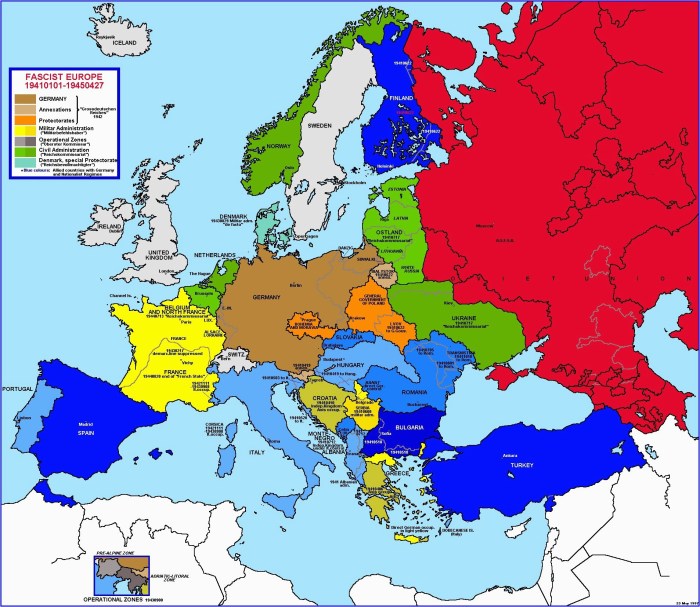
The European theater of World War II was characterized by the conflict between the Allied and Axis powers. The Allied powers, led by Great Britain, the Soviet Union, and the United States, fought against the Axis powers, led by Nazi Germany, Fascist Italy, and Imperial Japan.The
strategies and tactics employed by each side during the war were largely determined by their respective strengths and weaknesses. The Allies possessed a vast industrial capacity and a large pool of manpower, while the Axis powers had the advantage of a highly trained and experienced military.
Allied Strategies and Tactics
The Allies adopted a strategy of attrition, seeking to wear down the Axis powers through a series of prolonged and bloody battles. They also relied heavily on air power to bomb Axis targets and disrupt their supply lines.
If you’re looking for a blank map of WWII Europe to study up on the historical battlefields, you might also be interested in checking out our resource on nbme 12 answers step 2 . This guide provides comprehensive solutions to help you ace your medical exams.
But don’t forget to come back to your blank map of WWII Europe to continue exploring the strategic landscape of that pivotal conflict.
Axis Strategies and Tactics
The Axis powers, on the other hand, employed a strategy of blitzkrieg, or “lightning war.” This involved using fast-moving armored forces to penetrate enemy lines and encircle their forces. The Axis powers also made extensive use of propaganda to rally support for their cause.
Key Cities and Sites: Blank Map Of Wwii Europe
During World War II, numerous cities and historical sites across Europe bore witness to the conflict’s devastation and played pivotal roles in its course.
London, England
London, the capital of the United Kingdom, endured relentless aerial bombardment by the German Luftwaffe during the Blitz. The city’s iconic landmarks, such as Buckingham Palace and the Houses of Parliament, were targeted, causing significant damage and loss of life.
Stalingrad, Soviet Union
Stalingrad, a city on the Volga River, became the site of one of the bloodiest and most decisive battles of the war. The Battle of Stalingrad, fought between August 1942 and February 1943, resulted in the defeat of the German Sixth Army and a major turning point in the war.
Berlin, Germany
Berlin, the capital of Nazi Germany, was the target of intense Allied bombing raids and eventually fell to the Soviet Red Army in April 1945. The Reichstag building, a symbol of German power, was stormed by Soviet soldiers, marking the end of the war in Europe.
Normandy, France
Normandy, a region in northern France, was the site of the D-Day landings on June 6, 1944. The largest amphibious invasion in history, D-Day marked the beginning of the liberation of Western Europe from German occupation.
Auschwitz-Birkenau, Poland, Blank map of wwii europe
Auschwitz-Birkenau, a concentration camp in Nazi-occupied Poland, was the site of one of the most horrific genocides in human history. Over one million Jews and other minorities were murdered at the camp, making it a chilling reminder of the horrors of war.
Transportation and Logistics
Transportation and logistics played a critical role in World War II, influencing the course of the conflict and the outcome of battles. Both sides relied on efficient transportation systems to move troops, supplies, and equipment across vast distances.
Major Transportation Routes
- Trans-Siberian Railway:Connected Russia to the Far East, enabling the Soviet Union to transport troops and supplies to its eastern front.
- Burma Road:Linked China to Burma, providing a vital supply line for the Chinese Nationalist government during the Japanese invasion.
- Lend-Lease Act:A US program that provided military equipment and supplies to Allied nations, primarily through shipping routes across the Atlantic and Pacific oceans.
- Operation Overlord:The Allied invasion of Normandy in 1944 required the establishment of a massive transportation network to supply the invasion force.
- Operation Barbarossa:The German invasion of the Soviet Union in 1941 relied heavily on a complex transportation system to move troops and supplies deep into enemy territory.
Impact on the War
Efficient transportation systems allowed for the rapid deployment of troops and supplies, enabling surprise attacks and strategic maneuvers. Conversely, disruption of transportation routes could cripple military operations, leading to shortages and setbacks. For example, the German invasion of the Soviet Union initially benefited from a superior transportation system, but as the war progressed, Soviet partisans and Allied bombing campaigns disrupted German supply lines, contributing to their eventual defeat.
Post-War Europe
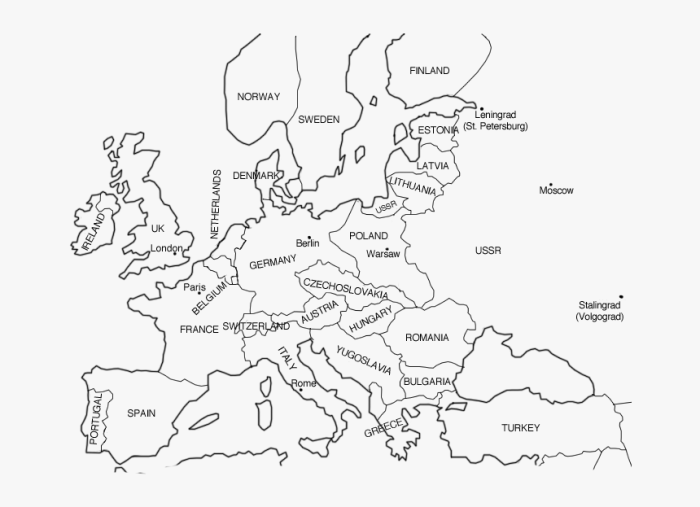
World War II left a profound impact on Europe, leading to significant political, economic, and social changes. The war had devastated the continent, leaving cities in ruins, economies shattered, and millions dead.
In the aftermath of the war, Europe was divided into two spheres of influence: the Soviet Union in the east and the Western Allies in the west. This division would shape the political landscape of Europe for decades to come.
Political Changes
- The Soviet Union emerged from the war as a superpower, controlling Eastern Europe and installing communist governments in many countries.
- The United States emerged as the dominant power in Western Europe, providing economic aid and military support to its allies.
- The Cold War, a period of political tension between the United States and the Soviet Union, dominated international relations for the next several decades.
- The European Union was founded in 1957 as a way to promote economic and political cooperation among Western European countries.
Economic Changes
- The Marshall Plan, a massive U.S. aid program, helped to rebuild Europe’s economy after the war.
- The Bretton Woods system, established in 1944, created a new international monetary system based on the U.S. dollar.
- Europe’s economy grew rapidly in the postwar period, leading to a period of prosperity known as the “Golden Age.”
Social Changes
- The war had a profound impact on European society, leading to a decline in traditional values and a rise in individualism.
- The war also led to the displacement of millions of people, creating a refugee crisis that would continue for many years.
- The postwar period saw the rise of new social movements, such as the civil rights movement and the feminist movement.
Helpful Answers
What key events are depicted on the “Blank Map of WWII Europe”?
The map highlights major battles, territorial changes, and the involvement of Allied and Axis powers throughout the war.
How does the map illustrate the strategic importance of geography in WWII?
The map emphasizes key geographical features, such as borders, rivers, and mountain ranges, and their influence on military campaigns.
What are some of the notable territorial changes that occurred during WWII?
The map showcases significant territorial shifts, including the expansion of Nazi Germany, the liberation of occupied territories, and the redrawing of national boundaries.